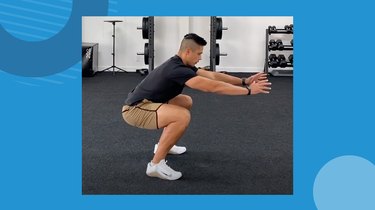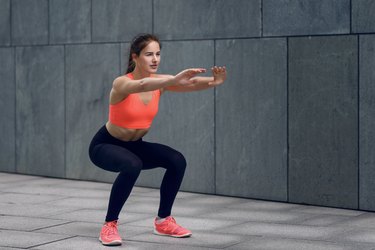

What's the first thing you do every morning? For most, the answer is probably: Use the bathroom. Well, in that case, another thing you may do each morning is perform an air squat (aka a body-weight squat).
- What is an air squat? A foundational leg exercise that involves lowering your body toward the ground and then standing back up. When you're doing it, it should look like kind of like you're sitting onto an invisible chair (or toilet) and then getting back up.
- What muscles does the air squat work? This exercise mainly targets your quads and glutes, says California-based physical therapist. Jereme Schumacher, DPT. It also builds core stability and some calf strength.
- Who can do air squats? Anyone! Those who have lower back pain should start with a modified squat before diving into the full move. (More on that below.)
Video of the Day
Excited to give this lower-body bedrock a try? Drop it down low and learn everything there is to know.
How to Do an Air Squat With Perfect Form

Watch the Full Tutorial
- Stand tall with your feet hip-width apart and brace your core. Focus on keeping your feet rooted into the ground and your core tight the entire time.
- Extend your arms out in front of you and slowly bend your knees as you push your hips back to lower toward the floor. Focus on lowering your body as if you were going to sit on a chair.
- Lower down as far as comfortable, or until your thighs are parallel with the floor.
- Pause for a moment at the bottom of your squat.
- On an exhale, reverse the motion by pressing through your heels to return to standing. As you stand, lower your arms back to your sides.
3 Air Squat Benefits
1. Guarding Against Injury
Whenever you sit down, you're doing an air squat exercise. In other words, you probably do some kind of squat each day, according to Schumacher. That's why getting the motion right can help you stay injury-free.
Sure, sitting down onto the couch probably isn't the most likely activity to cause a strain or sprain. But when you squat down to pick up a heavy box, for instance, good form protects your back. Master it now so you can use it later.
2. Building Strength and Endurance
Especially if you're new to strength training or don't want to work out with equipment like dumbbells, you'll love this exercise for its strengthening benefits, Schumacher says. During the move, your body acts like a weight, so your legs, glutes and abs really have to work.
Turning up the reps on your body-weight squats also builds muscular endurance, he says. If you're well-versed in the move, doing 20 or 30 back-to-back reps builds your stamina and muscle endurance.
3. Warming You Up for Heavy Lifts
If you prefer barbell and dumbbell squats, consider body-weight squats you new go-to dynamic warm-up exercise. They simultaneously get your heart pumping while upping your mobility, stability and strength through your lower body and core, Schumacher says.
Try doing a couple of high-rep sets right before getting under the barbell.
Related Reading
3 Common Air Squat Mistakes
1. Leaning Too Far Forward
As your hips open up toward the bottom of the squat, it's easy to let your chest fall forward toward the ground, Schumacher says. That's especially true if you have tight or immobile ankles. But too far of a lean can take away from the exercise's core-strengthening benefits.
While a little forward lean is OK, try to stay as upright as feels comfortable. If you notice you can't lower very far without tipping over, try doing some gentle calf stretches before your workouts.
2. Not Squatting Low Enough
How low should you air squat? As low as you can with good form and without pain. Over time, try to lower farther into each rep so that your thighs end parallel to the floor, Schumacher suggests. Lowering to your end range of motion boosts your glute and quad benefits.
3. Letting Your Knees Cave In
As you settle into the bottom of a squat, your shins should be roughly parallel to each other. When your knees start to collapse toward each other like they want to kiss, they put themselves in a pretty unstable (and potentially) unsafe position, called knee valgus.
Unfortunately, sometimes it can be hard to simply will away this common squat mistake, he says. Try adding some glute medius exercises like lateral band walks into your workout routine. As you strengthen your side glutes, your knee valgus will likely let up.
5 Body-Weight Squat Variations for Every Leg Workout
1. Sumo Squat
Walk your feet to the sides until they're about double shoulder-width apart, and you're ready to do a sumo squat. This positioning helps you up the focus on your hips and inner thighs. Try to keep a tall, upright torso.
2. Eccentric Squat
To make your body-weight squats harder, slow down the first portion of the motion. Lower toward the ground over the count of four. Pause, then return to standing in one second.
"Slowing down the eccentric or lowering part of an exercise keeps your muscles under tension longer, which helps build more strength," says Carolina Araujo, CPT, a New York-based certified personal trainer.
3. Isometric Squat
Kind of like a wall sit, this squat variation involves holding the bottom (hardest) part of the move squat. Once you lower as far as comfortable, pause for 15 seconds before you stand. As this gets easier, you can up the ante, holding the squat for 30 seconds or a minute at a time.
4. Prisoner Squat
The prisoner squat is a great way to add more of a core challenge to the lower-body exercise, Araujo says. Do your reps with the same air squat form, just with your hands interlaced behind your head. It's more challenging than you might think.
5. Jump Squat
To really get your heart pounding, add a jump. Come into your squat normally. Then, instead of returning to standing, drive forcefully though your feet to jump up into the air. As you land, immediately sink into your next rep.
For this variation, Araujo recommends swinging your arms for some extra momentum.
Was this article helpful?
150 Characters Max
0/150
Thank you for sharing!
Thank you for your feedback!